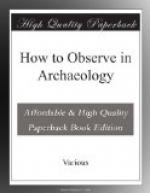In order to aid the visitor to get some idea of the age of a tell or other site from the antiquities found on its surface and its neighbourhood, and so to be able to give some idea of what is likely to be found in it, the following hints have been drawn up.
In the first place, most of the surface remains, are, as elsewhere, pottery sherds. These should tell us their date by their appearance. It must be said, however, that our experience on the subject of the development of Mesopotamian pottery is limited. Owing to the attention of Assyriologists having been so long focussed on the study of the cuneiform records, to the neglect of general archaeology, we have nothing like the knowledge of these things that we have in Egypt or in Greece. Such minutiae of information as our common knowledge of ceramic development in Egypt or in Greece gives us with regard to these countries, enabling us to date sites with great accuracy, are not vet available for Mesopotamia. And if for this reason all possible information as to the objects found on archaeological sites is desirable, it is also impossible yet to give the visitor any absolute guide to the distinctive appearance of pottery at every period. The main periods are known. The ‘prehistoric’, the Sumerian, the late Babylonian, and the Parthian styles are easily distinguishable. If a visitor is able to tell us that such-and-such a mound is prehistoric or is Parthian, or that settlements of both periods existed on it, this is what we want. One of the most general of criteria with regard to pottery is whether it is glazed or not. If glazed, it is, generally speaking, late. Other things besides pottery are of course found, and the presence or the absence of metal, and the occurrence of stone implements, are important. But it must be remembered that stone was used long into the ‘Bronze’ Age, and contemporaneously with copper. There is no sudden break between the two periods. Fragments of shell and mother-of-pearl, often with incised designs, are very characteristic of the earliest period. Coins are of late date; a tell with coins on it is certain to contain buildings as late as the fourth or third century B.C. (though it may also contain far older buildings as well). One of the most useful criteria of age is: Bricks. The form of the brick is a very good guide to date. The Babylonians used both kiln-baked and crude bricks. The oldest type, whether baked or crude, is plano-convex in form, and uninscribed. The mortar is bitumen. Later on rectangular bricks, often square, made in moulds, were introduced. These usually bore the name of the royal builder. Later on bricks became generally oblong and much like our own. In the sixth century the square shape was revived. Both shapes were in use at the Nebuchadnezzar period. Glazed bricks were then common. Under the Persians mortar took the place of bitumen. Under the Parthians and Sassanians, bricks were yellow, oblong, small, and very hard. Details will be found below, The names of various excavated sites are given in brackets as the ‘classical’ sources of information on certain points, and as the places from which type-antiquities have come to our Museums. Ancient names are in capitals; museums in italics.




